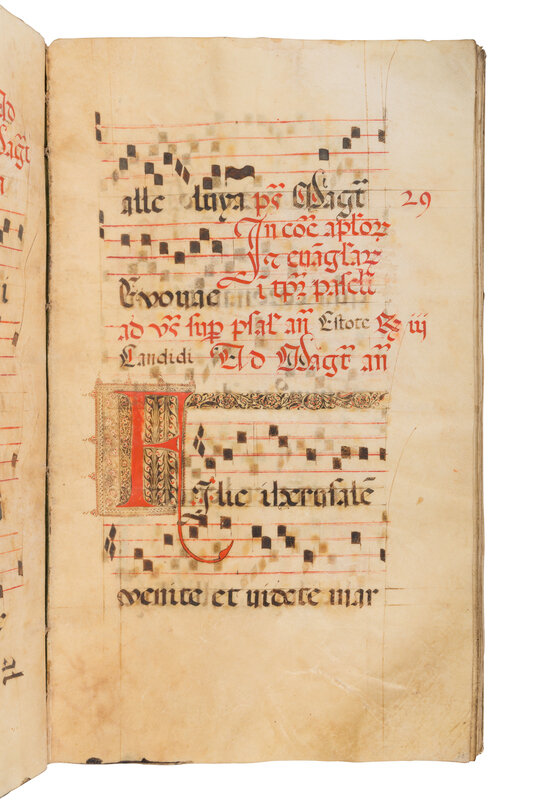Condition Report
Contact Information
Lot 66
POLISH CHOIR BOOK
Sanctoral, use of Dominicans, in Latin, illuminated manuscript on parchment [Poland, 1559]
Sanctoral, use of Dominicans, in Latin, illuminated manuscript on parchment [Poland, 1559]
Sale 2033 - Western Manuscripts and Miniatures
Jun 27, 2024
10:00AM CT
Live / Chicago
Own a similar item?
Estimate
$3,000 -
5,000
Price Realized
$4,445
Sold prices are inclusive of Buyer’s Premium
Lot Description
POLISH CHOIR BOOK
Sanctoral, use of Dominicans, in Latin, illuminated manuscript on parchment [Poland, 1559]
Sanctoral, use of Dominicans, in Latin, illuminated manuscript on parchment [Poland, 1559]
Renaissance manuscripts illuminated in Poland are exceedingly rare. This impressive Sanctoral for the use of Dominicans was copied and illuminated in Poland in 1559 by a man named Mylazo, whose name appears twice on the volume. A large historiated initial at the opening depicts the Dominican St. Vincent Ferrer.
480 x 265 mm, iv (modern paper) + 184 + iv (modern paper) leaves, original foliation in red ink in the outer margin, 1-184 (f. 119 omitted but not lacking, followed here), lacking two leaves of text, else complete [collation: i-xxii4, xxiii4-2 (foliated 92 and 93, with loss of text), xxiv-xliv4, xlv4+1 (f. 184 added)], with catchwords and strings, ruled in brown with double vertical bounding lines for one column of five lines of script and five staves per page (written space: 320 x 190 mm), square notation on red five-lines stave, rubrics in red, TWO-LINE PENNED INITIALS throughout, alternately in blue, red, yellow, and black on contrasting penwork, in a variety of compositions, two signed (“Mylazo fecit,” f. 12v; “Mylatio fecit,” f. 34), ONE FOUR-LINE INITIAL with a naked woman leaning drawn in brown ink, ONE FOUR-LINE HISTORIATED INITIAL in red and blue on red and blue penwork ground (historiated initial partly overpainted in the 20th century, parchment repair on ff. 1-2, ink damage on ff. 6v-7, parchment worn, soiled, and cockled throughout). Bound in an eighteenth-century white calf binding over pasteboards, spine raised on five bands, pastedowns in marbled paper (front pasteboard open, scratches and scuffs at the corner, lower headband cracked).
Provenance
(1) Copied and illuminated in 1559 for a Dominican establishment, as demonstrated by the first rubric identifying the Dominican saint St. Vincent Ferrer as “confessoris ordinis nostri” (“of our order”). This is supported by the inclusion of the feasts of St. Catherine of Siena, St. Antoninus of Florence, and St. Peter Martyr. The name of the illuminator and the modern provenance suggest that the manuscript was commissioned and produced in Poland in 1559.
(2) The manuscript has been described by the art consultant Adam Konopacki in Warsaw, Poland, in 1996; his written description accompanies the volume
(3) Private collection, USA.
Text
f. 1, St. Vincent Ferrer (5 April), rubric “In festo sancti Vincenti confessoris ordinis nostri 1559”; f. 29, Common of Apostles and every one martyr; f. 43, Common of Several Martyrs; f. 45v, St. Peter Martyr (29 April); f. 60v, St. Philip and St. James (May 1); f. 66, St. Catherine of Siena (29 April); f. 78v, Invention of the Cross (7 May); f. 90, St. Antoninus of Florence (10 May); f. 102v, St. John before the Latin Gate (6 May); f. 103, Nativity of John the Baptist (24 June); f. 127v, St. John and St. Paul Martyrs (26 June); f. 137, St. Peter and Paul, Vigil (29 June); f. 166, St. Paul, Feast (29 June).
The Choir Book follows the feasts of Sanctoral from April to June, opening with St. Vincent Ferrer. The inclusion of the Common of Apostles and Common of Several Martyrs is unusual, as these would rather belong to the section of the Temporal. The order of the feasts does not follow the conventional calendar and may rely upon a calendar specific to Poland.
Illumination
This volume opens with a large historiated initial of St. Vincent Ferrer (1350-1419), wearing a silver or grey mantle over a white robe as a Dominican friar, and holding a book in his left hand as he points toward the sun with his right hand. The gesture of pointing heavenward is a characteristic feature of the saint’s iconography and is often associated with the figure of Christ in Heaven or with a scroll inscribed with an extract of the Book of Revelation (14:7): “Timete Deum et date illi onorem quia venit” (“Fear God, and give glory to him”). A charismatic preacher, St. Vincent Ferrer warned of the imminence of death and Judgment Day, urging penance and repentance and thus converting thousands both within and outside Spain.
The illumination of the manuscript is signed in two instances by a Mylazo/Milatio, whose name appears in the body of two illuminated initials: “Mylazo fecit” on f. 12, “Mylatio fecit” on f. 34. He is likely responsible for the entire copying and illumination of the volume, which offers a subtle cycle of illuminated initials whose unusual shapes and fanciful penwork are often inspired by Renaissance penwork. The illuminator succeeds in varying the colors of the initials and motifs of the penwork grounds, which often extends onto the margins. The similarities between the initials and overall script of the volume may suggest that Mylazo also copied the manuscript, especially so in the possible context of a Dominican production. Manuscripts illuminated in Renaissance Poland are exceedingly rare: this exceptional volume of large dimensions may thus prompt further study.
Freeman’s | Hindman thank Senior Consultant Sandra Hindman and Elliott Adam for their assistance in preparing this sale.
This lot is located in Chicago.







